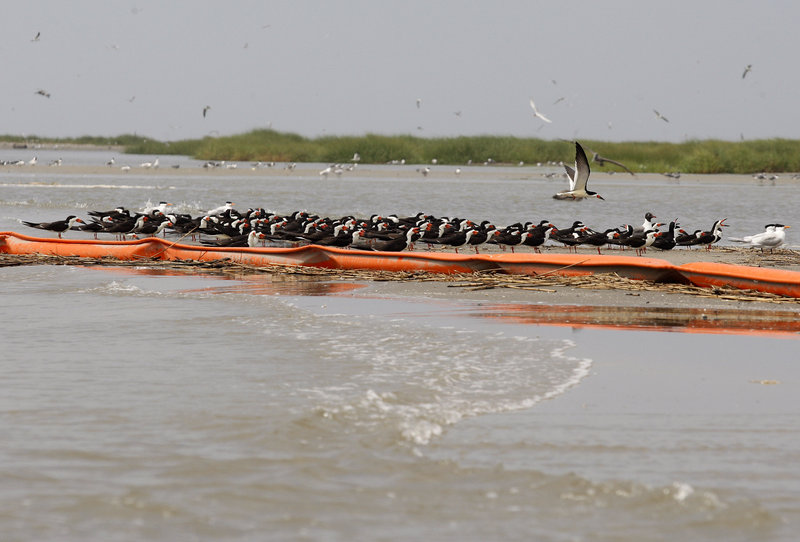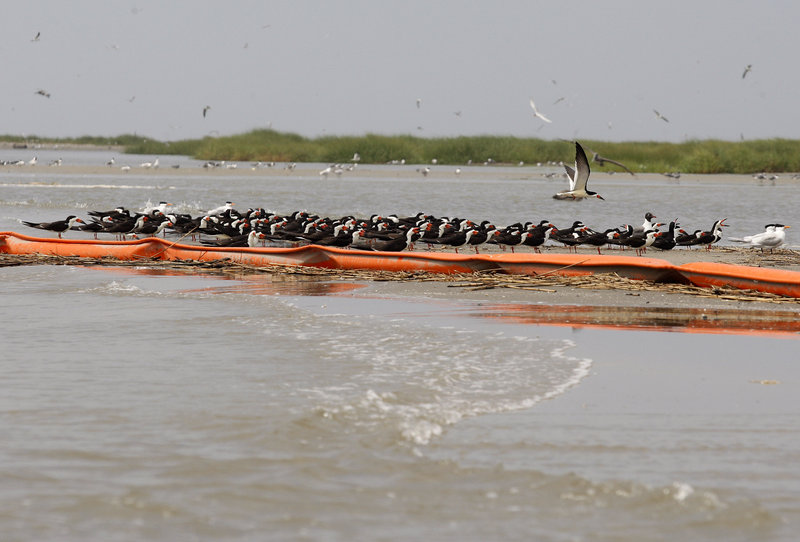NEW ORLEANS – The calamitous oil spill in the Gulf of Mexico isn’t just a mess for the people who live or work on the coast. If you drink coffee, eat shrimp, like bananas or plan to buy a new set of tires, you could end up paying more because of the disaster.
The slick has forced the shutdown of the gulf’s rich fishing grounds and could spread to the busy shipping lanes at the mouth of the Mississippi River, tying up the cargo vessels that move millions of tons of fruit, rubber, grain, steel and other commodities and raw materials in and out of the nation’s interior.
Though a total shutdown of the shipping lanes is unlikely, there could be long delays if vessels are forced to wait to have their oil-coated hulls power-washed to avoid contaminating the Mississippi.
Some cargo ships might choose to unload somewhere else in the U.S. That could drive up costs.
COSTS OF LOST TIME
“Let’s say it gets real bad. It gets blocked off and they don’t let anything in. They lose time, and they are very concerned about that,” said river pilot Michael Lorino. “It’s going to be very costly if they have to unload that cargo in another port and ship it back here because it was destined for here.”
When a tanker and a tugboat collided near New Orleans two years ago, oil cascaded down the river and some 200 ships stacked up, unable to move for several days while the Coast Guard had the vessels scrubbed. Millions of dollars were lost.
Several river boat pilots said the edge of the oil slick Monday was 15 to 20 miles off the Southwest Pass, where ships headed to New Orleans enter the Mississippi. The latest satellite image of the slick, taken Sunday night, indicates that it has shrunk since last week, but that only means some of the oil has gone underwater.
The new image found oil covering about 2,000 square miles, rather than the roughly 3,400 square miles observed last Thursday, said Hans Graber of the University of Miami.
The new image also shows that sizable patches have broken away and are moving to the north and east, Graber said.
Crews have been struggling to stop the more than 200,000 gallons a day spewing from the sea after an offshore drilling platform blew up and sank last month in a disaster that killed 11 workers. The accident is the worst U.S. oil spill since the tanker Exxon Valdez ran aground in Alaska, leaking nearly 11 million gallons of crude.
Chemical dispersants seemed to be helping to keep oil from floating to the surface, but crews haven’t been able to activate a shutout valve under water. And it could take another week before a 98-ton concrete-and-metal box is placed over one of the leaks to capture the oil.
More ominously, it could take three months to drill sideways into the well and plug it with mud and concrete.
BP LLC, whose deep-water well is gushing thousands of gallons of oil daily into the Gulf of Mexico, said Monday that it was “absolutely responsible” for stopping the leak, cleaning up the oil on the water’s surface and any resulting environmental damage.
“This not our accident, but it’s our responsibility,” said BP’s chief executive, Tony Hayward, said. “And where there are legitimate claims for business interruption, we will make them good.”
DEEP WATER CONTAINMENT
Doug Suttles, BP’s chief operating officer, said that construction on a multi-story steel containment system designed to drop over the main leak could be completed as early as today.
The system, which has never been used at this depth, would collect the oil and pipe it to a collection ship on the surface. Suttles said he hoped to have it “up and operating within a week.”
Hayward made a distinction between his company’s responsibility and that of Transocean Ltd., which operated the Deepwater Horizon rig that exploded and sank on April 20, triggering the spill. BP leased the rig and had contracted with Transocean to drill the well.
Transocean, the world’s biggest deepwater driller and operator of about 140 rigs, responded with a statement, saying it would “await all the facts before drawing conclusions.”
Restaurants, hotels, casinos and other coastal businesses from Florida to Texas are bracing for their own pain.
Dana Powell expects at least some lost business at the Paradise Inn in Pensacola Beach, Fla., and could see a different type of guest altogether: Instead of families boating, parasailing and fishing, workers on cleanup crews will probably be renting her rooms.
“They won’t be having as much fun,” she said, “but they might be buying more liquor at the bar, because they’ll be so depressed.”
And what will she serve in her restaurant? Hamburgers and chicken fingers instead of crab claws. Federal officials have shut down fishing for at least 10 days from the Mississippi River to the Florida Panhandle.
In the Chandeleur Sound on Monday, about 40 miles northeast of Venice, La., thick, heavy oil formed long clumps that looked like raw sewage. Dying jellyfish could be seen in the water. A dolphin surfaced nearby but did not appear to be in distress.
The news was better from Mississippi to the Florida Panhandle, where the sheen isn’t expected to touch beaches before Thursday. Wind and sea currents have helped to keep the oil away from points farther west, said Coast Guard Capt. Steve Poulin.
CARGO DISRUPTIONS LIKELY
Hundreds of Coast Guard crews, private vessels and others are working offshore fighting to keep the slick at bay.
Poulin used a map that projected what people can expect to see when the oil begins to hit. The outermost layer will include sticky tar balls that can adhere to bird feathers and accumulate in grasses and marshes. The next layer will have bigger pancakes of emulsified oil.
In Alabama, scores of shrimp boats sat at dock in Bayou La Batre, their crews unable to work. Vietnamese immigrant Minh V. Le, who owns two trawlers, said: “I’m confused about how I’m going to survive, and how my crews are.”
The Port of New Orleans handled 73 millions tons of cargo in 2008, including coffee from South America and steel from Japan, Russia and Mexico.
Last year, it imported nearly 260,000 tons of rubber from such countries as Indonesia and Malaysia, making it nation’s No. 1 gateway for natural rubber.
Upriver is the Port of South Louisiana, the nation’s busiest port with 224 million tons of cargo a year — mostly grain, other agricultural commodities and chemicals. Farther east lies Mississippi’s Port of Gulfport, the nation’s second-largest importer of green fruit. Central American bananas from Chiquita and Dole account for a big chunk of its cargo.
About 60 percent of the grain exported from the U.S. goes through the Southwest Pass. If the spill delays barge traffic going down the Mississippi, prices for corn, soybeans and wheat could rise quickly on global markets, said Greg Wagner, a commodity analyst.
Grain prices within the U.S. could actually fall if shipments are unable to leave and the grain begins piling up at silos in the U.S. But the price decreases would probably be small and wouldn’t show up at the grocery store anytime soon, said Seth Meyer, an agricultural transportation analyst at the University of Missouri.
While a port shutdown would be devastating to the Gulf Coast region, many economists believe damage to the $14.6 trillion U.S. economy could be small.
Cargo can be rerouted to other ports, and the income would be shifted but not lost. Even the lost income from tourism and fishing could be offset by more spending on cleanup.
“The U.S. economy is adaptable,” said Martin Regalia, chief economist at the U.S. Chamber of Commerce. “When natural disasters strike, money may be lost in one area but can be made up by spending in other areas. It is more than a nuisance, but it is not a calamity in an economic sense.”
— The Los Angeles Times contributed to this report.
Send questions/comments to the editors.




Success. Please wait for the page to reload. If the page does not reload within 5 seconds, please refresh the page.
Enter your email and password to access comments.
Hi, to comment on stories you must . This profile is in addition to your subscription and website login.
Already have a commenting profile? .
Invalid username/password.
Please check your email to confirm and complete your registration.
Only subscribers are eligible to post comments. Please subscribe or login first for digital access. Here’s why.
Use the form below to reset your password. When you've submitted your account email, we will send an email with a reset code.